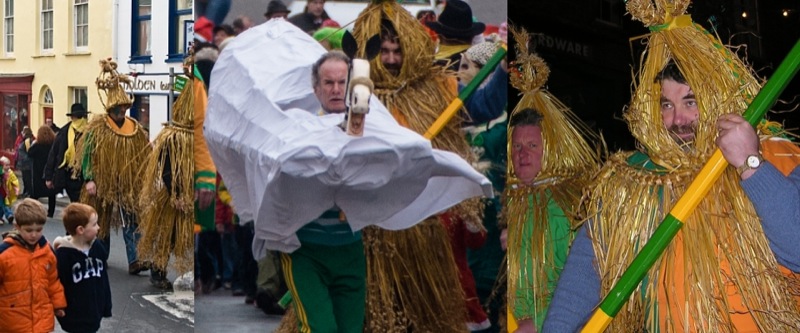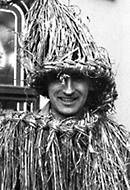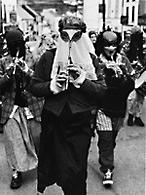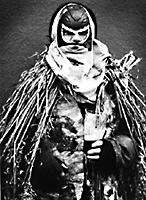Hunting the Wren

The following article and photographs are reproduced with permission from the November/December 1997 issue of "Cara", the Aer Lingus on-board magazine.
The article is written by Peter Wood, who is originally from Co. Monaghan, with photography of the Dingle Wren by Christy McNamara, who is originally from Co. Clare. Peter and Christy have collaborated on a book entitled "The Living Note: The Heartbeat of Irish Music", published by O'Brien Press and Robert Rinehart.
On St. Stephen's Day , December 26th, crowds of people take to the roads in various parts of Ireland, dressed in motley clothing, wearing masks or straw suits and accompanied by musicians – remembering a festival with antecedents that long predate Christmas. The Wren – sometimes pronounced and written, wran – was once common all over Ireland. In some areas, the Wrenboys are called Mummers and the festival has a strong English influence, incorporating characters like St. George.
Birds have great prominence in Irish mythology. They were seen as intermediaries, in pre-Christian times, between this world and the next. The flight patterns of birds, like the wren, were used as auguries by the Druids. Indeed, some believe, the Gaelic word for wren – dreoilín – derives from two words, draoi ean, or Druid bird.
 When, according to legend, the birds held a parliament, it was decided that whichever of them flew the highest would rule over all the others. The eagle soared higher than any, until it tired and the tiny wren emerged from its tail feathers and climbed far above it.
When, according to legend, the birds held a parliament, it was decided that whichever of them flew the highest would rule over all the others. The eagle soared higher than any, until it tired and the tiny wren emerged from its tail feathers and climbed far above it.
Mysteriously, the wren has a reputation for treachery. A wren is said to have betrayed Irish soldiers fighting the Norsemen by beating its wings on their shields. The wren, too, is blamed for betraying St. Stephen, the first Christian martyr. This is the usual explanation why the wren is the hunted bird on St. Stephen's day. It has also been argued that the antipathy shown towards the bird dates from early Christian opposition to the Druidic rites that surrounded it. Today, the wren – as a feature of the event – survives only in the rhyme and in the name of the day, although, in former times, it was hunted and nailed to a pole at the head of the procession.
In West Kerry, the focal point of the Wrenboys parade is a hobby horse. A pantomime-type horse with a wooden head, snapping jaws and a body made from cloth stretched across a timber frame, it is worn on the shoulders of one of the members of the Wren – who whirls and capers at the head of the parade. The horse, for social and military reasons, was of great importance in ancient Ireland. Horses could be both lucky and unlucky, and they had strong associations with the rights to kingship and with fertility. The horse was so important that its introduction to Ireland was credited to the god Lugh. The greatest of the Celtic gods, his name occurs across the continent in placenames like Lyon and Leiden. The cult of the horse was also opposed by the early Christians.
 The straw suits worn by the Wrenboys also have historical resonances, though more recent ones. In the 18th and 19th centuries, they were worn as disguises by the Whiteboys during Ireland's prolonged agrarian wars. The suit is woven in three parts: head, chest, and skirt. The straw of choice for the suits is that which comes from oats and, since there is little demand for oats, good straw is becoming increasingly difficult to find. In many cases, oats are grown specifically for the Wren.
The straw suits worn by the Wrenboys also have historical resonances, though more recent ones. In the 18th and 19th centuries, they were worn as disguises by the Whiteboys during Ireland's prolonged agrarian wars. The suit is woven in three parts: head, chest, and skirt. The straw of choice for the suits is that which comes from oats and, since there is little demand for oats, good straw is becoming increasingly difficult to find. In many cases, oats are grown specifically for the Wren.
The Wren, in common with many customs in rural Ireland, came close to extinction. From the twenties and thirties onward emigration took a great toll among those who would have taken part. There was strong clerical opposition – the money raised in the collections the Wrenboys took up went towards holding a ball in a local hotel or public house and naturally there was alcohol involved. The Church saw the Wren, as it saw the house dances that kept traditional music alive in those times, as an "occasion of sin."
That the Wren survived at all was due to the efforts of a few individuals and small groups of people working in isolation. Nowadays, the Wren is enjoying a revival. Listowel, County Kerry, holds an annual competition. The legendary Wrens of the Dingle Peninsula are the focus of intense local competition. Dublin, too, has a festival, held on Sandymount Green. Whatever its provenance (there is a similar festival in Lerwick on Shetland, and its form finds echoes across Europe in the hobby horse, and the hunting of a small bird on one day of the year) the Wren in Ireland is not fixed in time. Like much else in Irish culture, the Wrenboys have adapted and changed. Their masks and costumes reflect change, and reflect too, perhaps, the current demonology of Irish society – long after her fall from power, former British Prime Minister Margaret Thatcher still figures prominently in the masks worn in many a Wren.
 Fundamentally though, the Wren is a local event, reflecting the communities it springs from – whether in the North of the country, or Wexford, Woodford in Galway or the west of Kerry. Th Kerry writer and dramatist, Sigerson Clifford, was all his life a kind of exile in his own country from the town he loved, Cahirciveen. He's best remembered for his great ballad, The Boys of Barr na Straide, two lines of which formed his epitaph.
Fundamentally though, the Wren is a local event, reflecting the communities it springs from – whether in the North of the country, or Wexford, Woodford in Galway or the west of Kerry. Th Kerry writer and dramatist, Sigerson Clifford, was all his life a kind of exile in his own country from the town he loved, Cahirciveen. He's best remembered for his great ballad, The Boys of Barr na Straide, two lines of which formed his epitaph.
I'll take my sleep in those green fields, the place my life began, Where the boys of Barr na Straide went hunting for the wren.
For many people in more distant exile, the 26th of December holds a special resonance – the day the whistles, fifes and drums thunder like waves, rising in crescendos to drive the dark of winter away. Pagans and Christians forgotten, all the one now. "Up Sraid Eoin! We never died a winter yet," as they say on at least one street in Dingle town.
TEXT COPYRIGHT 1997 BY PETER WOODS PHOTOGRAPHY COPYRIGHT 1997 BY CHRISTY McNAMARA